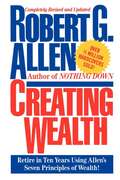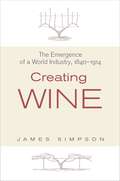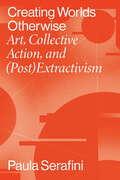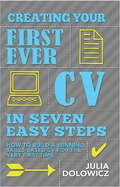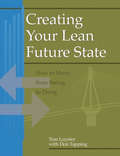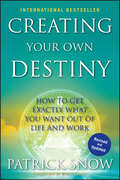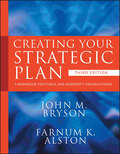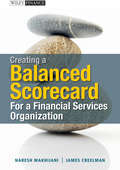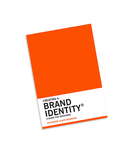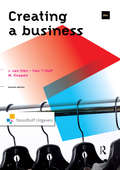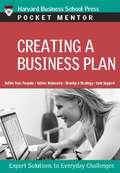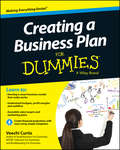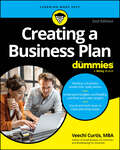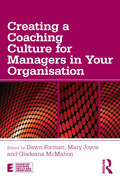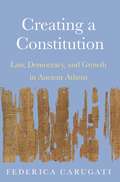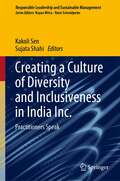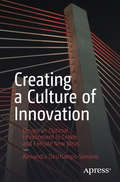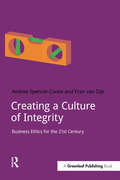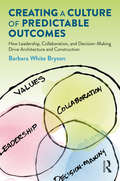- Table View
- List View
Creating Wealth: Retire in Ten Years Using Allen's Seven Principles of Wealth
by Robert G. AllenPopular speaker, multimillionaire, and author of the all-time bestselling real-estate book Nothing Down, Robert G. Allen knows how to bring you financial success. With his seminars sweeping the nation, Allen is at the cutting edge of strategic wealth creation now more than ever. And in this completely revised edition of his classic bestseller Creating Wealth Allen gives you the basic principles that you need to stop thinking poor and start growing rich. Moving beyond just real estate, Allen goes straight to the core of people's inner motivations and beliefs about money to give you all the fundamentals of wealth creation. By developing a wealthy mind-set, anyone can take off into financial self-reliance -- and Allen shows you how. He explains the ways in which most of us have been programmed to think that only saving is good and debt and risk are bad, so that in our efforts to gain security, we cheat ourselves out of getting rich. The key to changing that mind-set is Allen's unique integration of real estate with other wealth-generating investments. In his trademark, easy-to-understand style Allen spells out all his practical applications and shows you how to: Take advantage of recent tax laws Use leverage to multiply holdings while minimizing risks Benefit from high-yield discount mortgages Acquire long-term profits in gold and silver coins Set up corporations and trusts to protect assets Find the highest rate of return with the greatest liquidity As Robert Allen has proved in his own life -- becoming a multimillionaire well before he was thirty-five -- it doesn't matter how much or how little money you have when you start as long as you understand the right principles -- timeless principles that can make you a fortune.
Creating Wine: The Emergence of a World Industry, 1840-1914 (The Princeton Economic History of the Western World #36)
by James SimpsonToday's wine industry is characterized by regional differences not only in the wines themselves but also in the business models by which these wines are produced, marketed, and distributed. In Old World countries such as France, Spain, and Italy, small family vineyards and cooperative wineries abound. In New World regions like the United States and Australia, the industry is dominated by a handful of very large producers. This is the first book to trace the economic and historical forces that gave rise to very distinctive regional approaches to creating wine. James Simpson shows how the wine industry was transformed in the decades leading up to the First World War. Population growth, rising wages, and the railways all contributed to soaring European consumption even as many vineyards were decimated by the vine disease phylloxera. At the same time, new technologies led to a major shift in production away from Europe's traditional winemaking regions. Small family producers in Europe developed institutions such as regional appellations and cooperatives to protect their commercial interests as large integrated companies built new markets in America and elsewhere. Simpson examines how Old and New World producers employed diverging strategies to adapt to the changing global wine industry. Creating Wine includes chapters on Europe's cheap commodity wine industry; the markets for sherry, port, claret, and champagne; and the new wine industries in California, Australia, and Argentina.
Creating Worlds Otherwise: Art, Collective Action, and (Post)Extractivism (Performing Latin American and Caribbean Identities)
by Paula SerafiniExtractivism has increasingly become the ground on which activists and scholars in Latin America frame the dynamics of ecological devastation, accumulation of wealth, and erosion of rights. These maladies are the direct consequences of longstanding extraction-oriented economies, and more recently from the expansion of the extractive frontier and the implementation of new technologies in the extraction of fossil fuels, mining, and agriculture. But the fields of sociology, political ecology, anthropology, and geography have largely ignored the role of art and cultural practices in studies of extractivism and post-extractivism. The field of art theory, on the other hand, has offered a number of texts that put forward insightful analyses of artwork addressing extraction, environmental devastation, and the climate crisis. However, an art theory perspective that does not engage firsthand and in depth with collective action remains limited and fails to provide an account of the role, processes, and politics of art in anti- and post-extractivist movements.Creating Worlds Otherwise examines the narratives that subaltern groups generate around extractivism, and how they develop, communicate, and mobilize these narratives through art and cultural practices. It reports on a two-year research project into creative resistance to extractivism in Argentina and builds on long-term engagement working on environmental justice projects and campaigns in Argentina and the UK. It is an innovative contribution to the fields of Latin American studies, political ecology, cultural studies, and art theory, and addresses pressing questions regarding what post-extractivist worlds might look like as well as how such visions are put into practice.
Creating Your Digital Portfolio: The Essential Guide to Showcasing Your Design Work Online
by Ian ClazieThis book will help graphic designers, illustrators, and other creative professionals navigate the challenge of creating a digital portfolio. It contains practical advice to getting your work into a portable digital format ready to share on the web. It also discusses the thinking behind creating a portfolio, your objectives, and communication strategy.
Creating Your First Ever CV In Seven Easy Steps: How To Build A Winning Skills-based Cv For The Very First Time
by Julia DolowiczThis friendly and accessible book coaches you through the process of writing your first ever CV. You may be in school and about to apply for a part time job; you may be wanting to approach a company for work experience; or you may have been lucky enough to get a job after school without compiling a CV and you want to progress and move on so you need to start from scratch. Creating a first CV, with no employment history, can be a daunting task. But just because you haven't had a work/employment history, doesn't mean you have no skills. However, if you're starting out and you want to stand out, you have to be clear about those skills and make them count. This book breaks down the process of writing your CV into seven steps, short activities that will subsequently be used to build upon each other. It will help you identify those skills - which we all have and bring them to life. Gather it - collect the material for your principal CV and profile. Develop it - start to play with the information you have collected and apply it to two real or dream jobs you would like to apply for. Evidence it - learn how to demonstrate where and how you have ability and proficiency. Shape it - look at the structure, format, style and layout of your CV. Build it - bring together all the information you have collected, expanded, and evidenced so far. Polish it - you will have gathered more information than you ever thought you would, so here you will add and subtract and reshape. Complete it - this final step encourages you to review, refine and rejig your CV so that it reads well and flows There is also a section on writing cover letters, completing an application form and preparing for interview
Creating Your First Ever CV In Seven Easy Steps: How to build a winning skills-based CV for the very first time
by Julia DolowiczThis friendly and accessible book coaches you through the process of writing your first ever CV. You may be in school and about to apply for a part time job; you may be wanting to approach a company for work experience; or you may have been lucky enough to get a job after school without compiling a CV and you want to progress and move on so you need to start from scratch. Creating a first CV, with no employment history, can be a daunting task. But just because you haven't had a work/employment history, doesn't mean you have no skills. However, if you're starting out and you want to stand out, you have to be clear about those skills and make them count. This book breaks down the process of writing your CV into seven steps, short activities that will subsequently be used to build upon each other. It will help you identify those skills - which we all have and bring them to life. Gather it - collect the material for your principal CV and profile. Develop it - start to play with the information you have collected and apply it to two real or dream jobs you would like to apply for. Evidence it - learn how to demonstrate where and how you have ability and proficiency. Shape it - look at the structure, format, style and layout of your CV. Build it - bring together all the information you have collected, expanded, and evidenced so far. Polish it - you will have gathered more information than you ever thought you would, so here you will add and subtract and reshape. Complete it - this final step encourages you to review, refine and rejig your CV so that it reads well and flows There is also a section on writing cover letters, completing an application form and preparing for interview
Creating Your Growth Framework: A Discovery-Driven Approach
by Ian C. Macmillan Rita Gunther McgrathOne of the most common obstacles to a successful growth program is the lack of clarity about the overall strategy at the outset. In order to overcome this obstacle, senior executives need to establish clear, focused guidelines for the pursuit of growth. This chapter considers the growth challenge at the CEO or senior team level as these executives begin to define the growth frame for the entire enterprise. The outcome of this process is a set of propositions about which initiatives will be needed to realistically create growth. As a result, everybody else in the company will be clear about what kinds of growth opportunities are a good strategic fit. This chapter is excerpted from "Discovery-Driven Growth: A Breakthrough Process to Reduce Risk and Seize Opportunity."
Creating Your Lean Future State: How to Move from Seeing to Doing
by Tom Luyster Don TappingMove beyond Value Stream Mapping and Create Your Lean Future In Creating Your Lean Future State: How to Move from Seeing to Doing, Tom Luyster, with Don Tapping, details the implementation of lean after the creation of current and future state maps. This book is a follow-up to the successful Value Stream Management: Eight Steps to Planning, Mapping
Creating Your Own Destiny: How to Get Exactly What You Want Out of Life and Work
by Patrick SnowA motivational speaker and entrepreneur presents the ultimate ten-step road map for personal and professional success! This book is for anyone who wants more out of life. Most people want more time, money, freedom, while other seek better health, deeper love, and more sustainable happiness in life. Creating Your Own Destiny shows you how to get all these things through a simple ten-step step success road map. This book not only helps you soul-search for your true passions, but also provides simple strategies that will help you get what you ultimately what out of life. You will learn how to: -Visualize your desired future and make it your reality -Attain all your dreams while keeping family top priority -Create a winning game plan that fulfills your passions -Build wealth through home-based business ownership -Find solutions for dealing with fear and failure -Gain more time, money, freedom, health, love, happiness -Apply the ultimate success secret in life -Secure personal freedom when you create your own destiny
Creating Your Own Personal Learning Strategy: A Step-by-Step Approach
by Robert J. ThomasA Personal Learning Strategy (PLS) will aid you in the process of learning from experience-especially, though not exclusively, crucible experiences-and it will enhance your ability to adapt to change as a leader. This chapter shows you how to craft a Personal Learning Strategy.
Creating Your Strategic Plan
by John M. Bryson Farnum K. Alston"Creating Your Strategic Plan" is the best-selling companion workbook to Bryson's landmark book, Strategic Planning for Public and Nonprofit Organizations. Whether used with the main text or by itself, this thoroughly revised third edition provides a step-by-step guide to putting strategic planning to work in public and nonprofit organizations. The workbook contains new and revised worksheets and additional material on readiness assessment, teamwork, stakeholder analysis, visioning, strategic issue identification, and implementation. "Creating Your Strategic Plan" covers each of the ten key steps of the strategic planning process and each step description includes sections on purpose and possible desired planning outcomes. The authors provide clear instructions for creating a strategic plan tailored to the needs of the individual organization. The workbook features practical advice to help readers: Refine mission and valuesAssess the internal and external environmentIdentify and frame strategic issuesFormulate strategies to manage the issuesCreate, review, and adopt the strategic planAssess the processFrom setting up the meeting room, to establishing a vision of--and plan for--the future, this indispensable workbook will take readers through every step of the strategic planning process.
Creating a Balanced Scorecard for a Financial Services Organization
by Naresh Makhijani James CreelmanHow to tap the power of the balanced scorecard, for financial services organizationsDesigned to help financial services organizations build and implement the strategic management framework known as the balanced scorecard, Creating a Balanced Scorecard for a Financial Services Organization is the book you need to ensure accountability, transparency, and risk management in your enterprise. The financial crisis revealed the many shortcomings of the industry, but with this book in hand you can make the most of the mistakes of the past to build a better, stronger business that balances both short- and long-term goals.Rich in the latest theoretical thinking and incorporating case studies that show the balanced scorecard system in action, the book covers both financial and non-financial performance perspectives in one comprehensive volume. Written by two leading practitioners with years of real-life experience, the book is the definitive step-by-step guide to implementing the balanced scorecard throughout your organization, aligning your whole business with your strategic goals.Includes everything you need to improve performance transparency, accountability, governance procedures, risk management, and more for financial services organizations of any kindPacked with expert advice and case studies that show the ideas presented in actionWritten by leading experts who have successfully implemented the balanced scorecard system in their own companiesAccessible and in-depth, Creating a Balanced Scorecard for a Financial Services Organization is the book you need to improve your business.
Creating a Brand Identity: A Guide for Designers
by Catharine Slade-BrookingCreating a brand identity is a fascinating and complex challenge for the graphic designer. It requires practical design skills and creative drive as well as an understanding of marketing and consumer behaviour. This practical handbook is a comprehensive introduction to this multifaceted process.Exercises and examples highlight the key activities undertaken by designers to create a successful brand identity, including defining the audience, analyzing competitors, creating mood boards, naming brands, designing logos, presenting to clients, rebranding and launching the new identity.Case studies throughout the book are illustrated with brand identities from around the world, including a diverse range of industries – digital media, fashion, advertising, product design, packaging, retail and more.
Creating a Brand Identity: A Guide for Designers
by Sue JenkynCreating a brand identity is a fascinating and complex challenge for the graphic designer. It requires practical design skills and creative drive as well as an understanding of marketing and consumer behaviour. This practical handbook is a comprehensive introduction to this multifaceted process.Exercises and examples highlight the key activities undertaken by designers to create a successful brand identity, including defining the audience, analyzing competitors, creating mood boards, naming brands, designing logos, presenting to clients, rebranding and launching the new identity.Case studies throughout the book are illustrated with brand identities from around the world, including a diverse range of industries – digital media, fashion, advertising, product design, packaging, retail and more.
Creating a Business
by Jenny van Sten-van't HoffThere is more to setting up a successful business than just a good idea. Creating a Business examines concisely all the relevant aspects: the excitement and satisfaction that business entails, the challenges that face the entrepreneur, the risks that lie in wait. The textbook is organized around a practical example: a company setting out to launch a new line of clothing. Aspects of setting up a business, including management, marketing, legislation, and financial management are examined. Including pedagogical features, such as end-of-chapter questions and illustrations, Creating a Business will interest students of small business and entrepreneurship.
Creating a Business Plan
by Harvard Business School PressEvery business needs a business plan--a plan to meet the expected and unexpected opportunities and obstacles the future holds. This book will help you take a long, hard look at each element of the plan and show you how to communicate the right message to the right people, and maximize the chances of getting your business launched.
Creating a Business Plan For Dummies
by Veechi CurtisEverything you need to know to design a profitable business plan Whether you're starting a new business or you’ve been trading for a while, Creating a Business Plan For Dummies covers everything you need to know. Figure out whether your business idea is likely to work, how to identify your strategic advantage, and what you can do to gain an edge on the competition. Discover why a business plan doesn't have to be a thrity-page document that takes days to write, but can be a simple process that you do in stages as you work through your business concept. Learn how to prepare an elevator pitch, create a start-up budget, and create realistic sales projections. Discover how to predict and manage expenses, and assemble a financial forecast that enables you to calculate your break-even. Look at the risk involved in this business and experiment with different scenarios to see if you’re on the right track. Explains how to create a one-page business plan in just a few hours Takes a simple step-by-step approach, focusing on budgets, financials, and everyday practicalities Offers focused guidance on managing cashflow, designing marketing plans, and establishing a long-term vision for your business Includes access to downloadable templates and worksheets, as well as helpful online audio and video components Written by Veechi Curtis, bestselling author and business consultant A good business plan is the first step to success for any new business, and getting it right can mean the difference between big profits and big trouble. Creating a Business Plan For Dummies gives you the detailed advice you need to design a great business plan that will guide your business from concept to reality.
Creating a Business Plan For Dummies
by Veechi CurtisLearn how to create a sound, profitable business plan that will take your business to the next level Whether you're starting a new business or you’re looking to revitalise your strategy, Creating a Business Plan For Dummies covers everything you need to know. This step-by-step guide shows you how to figure out whether your business idea will work. With Dummies, your business plan can be a simple process that you tackle in stages. You’ll identify your strategic advantage, discover how to gain an edge over your competitors and transform your ideas to reality using the latest tools (including AI!). No matter what type of business you have — products or services, online or bricks-and-mortar — you’ll learn how to create a start-up budget and make realistic projections. How will you predict and manage your expenses? When will your business break even? Dummies will help you assemble a financial forecast that leaves you confident in your calculations! Learn how to review potential risk, experiment with different scenarios to see if you’re on the right track and hone your mindset for a better work-life balance. Establish a smart business model that really works Identify your edge, get ahead of competitors and win the game Create an elevator pitch and a one-page business plan to woo investors Demystify financial projections, build a budget and create cashflow Work smarter by taking advantage of the latest AI and online business tools Having a good plan is the first step to success for any business. Getting it right can mean the difference between big trouble and big profits. Creating a Business Plan For Dummies gives you the detailed advice you need to guide your business all the way from concept to reality.
Creating a Coaching Culture for Managers in Your Organisation (Essential Coaching Skills and Knowledge)
by Dawn Forman Mary Joyce Gladeana McMahonCreating a Coaching Culture for Managers in your Organisation is for managers leaders and coaches interested in extending the practice of coaching to achieve broader organisational outcomes. The book offers a practical approach on how to use coaching strategically to create a culture that supports change, builds leadership capacity, and achieves a high degree of alignment between the goals and aspirations of organisations, and their staff. The authors provide rich case study examples of how coaching has been used in a range of organisations to build capacity, leadership learning, and support new ways of working. Taken together, the chapters provide insight into how organisations can develop a culture that promotes engagement, open and dialogic communication, clarity of expectations, and high performance. This valuable text is a timely contribution to current thinking on leadership, management, and organisation development. It will be of interest to managers, leaders, HR professionals and coaching professionals, as well as students interested in coaching techniques, counsellors, and psychotherapists.
Creating a Community of Purpose: Management Innovation in Action
by Gary Hamel Bill BreenThis chapter provides a portrait of Whole Foods Market and its game-changing business model, in which a company is not just a company but a community of people working to make a difference in the world, and mission matters as much as the bottom line. This chapter was originally published as chapter 4 of "The Future of Management."
Creating a Constitution: Law, Democracy, and Growth in Ancient Athens
by Federica CarugatiA comprehensive account of how the Athenian constitution was created—with lessons for contemporary constitution-buildingWe live in an era of constitution-making. More than half of the world's constitutions have been drafted in the past half-century. Yet, one question still eludes theorists and practitioners alike: how do stable, growth-enhancing constitutional structures emerge and endure? In Creating a Constitution, Federica Carugati argues that ancient Athens offers a unique laboratory for exploring this question. Because the city-state was reasonably well-documented, smaller than most modern nations, and simpler in its institutional makeup, the case of Athens reveals key factors of successful constitution-making that are hard to flesh out in more complex settings.Carugati demonstrates that the institutional changes Athens undertook in the late fifth century BCE, after a period of war and internal strife, amounted to a de facto constitution. The constitution restored stability and allowed the democracy to flourish anew. The analysis of Athens's case reveals the importance of three factors for creating a successful constitution: first, a consensus on a set of shared values capable of commanding long-term support; second, a self-enforcing institutional structure that reflects those values; and, third, regulatory mechanisms for policymaking that enable tradeoffs of inclusion to foster growth without jeopardizing stability.Uniquely combining institutional analysis, political economy, and history, Creating a Constitution is a compelling account of how political and economic goals that we normally associate with Western developed countries were once achieved through different institutional arrangements.
Creating a Culture of Diversity and Inclusiveness in India Inc.: Practitioners Speak (Responsible Leadership and Sustainable Management)
by Kakoli Sen Sujata ShahiThe book addresses the concept of diversity and inclusiveness (D&I) and brings stories from the corporate, practitioners, think tanks and NGOs. It advocates the need and implementation of the D&I concept to build society of the future. It strives to bring out a focused approach in connecting “Theory to Practice”. Every chapter delves into a different area and presents real-time practices as well as the challenges and the way forward. The book explains the various levels at which discrimination can occur such as demographic profiles, regional differences, religious alliances, college pedigree, marital status, sexual preferences, physical disability and health differentiation, pregnancy or returning mothers and technology competence. The book cites examples of inclusion from progressive organizations such as ABB India, Marico, TCS, PNB Metlife and Alsthom. Presenting the business case of D&I, the book emphasizes on creating a robust D&I strategy with a road map and alignment through internal and external frameworks as well as periodic audits. The Responsible, Accountable, Consultant and Informed (RACI) matrix is discussed while setting up the D&I analytics framework within the organization. The book also presents the growing role of artificial intelligence tools that can empower employees to participate in the D&I journey of an organization. It shares how tools such as Balloonr, Glint, Organization View, Planbox, Pluto and Waggl have been specially designed to allow employees to anonymously provide ideas and respond to ideas provided by others. Going forward, the D&I practices will have to be more customized than generalized, and this book brings up real evidences to make its point
Creating a Culture of Innovation: Design an Optimal Environment to Create and Execute New Ideas
by Alexandra Deschamps-SonsinoDeconstruct the history of patterns of innovation in business and connect them to existing and failed attempts in management consultancies, engineering, web technologies and academic institutions. This book shows you how to create an optimal environment at work for growth and innovation. Many large-scale organizations eventually invest in research and innovation as a dedicated part of their businesses. In doing so, they are faced with two choices: build their own practice of innovation or enact patterns of innovation created before them, ones they perceived as "tried and tested." In this book, you will see how patterns of innovation touch many aspects of a worker’s life: from how their work is presented to others, job titles, working environment, and expectations around output. Every chapter will offer a history of these patterns and examples of how they have succeeded and failed within organizations. What You Will LearnIdentify how innovation is named and highlighted in organizationsReveal ways to champion innovation to clients and the outside world, from trade shows and conferences inside the officeUncover ways companies acquire innovation, including incubators or mergersDiscover the conditions for innovation to happen every day, including office layouts, time management, communication structures, and expectation management Who This Book Is ForTech start-up/scale-up founders, management consultants, managing directors, innovation managers and heads of R&D, academic researchers, interior designers, and architects
Creating a Culture of Integrity: Business Ethics for the 21st Century (Doshorts Ser.)
by Andrea Spencer-Cooke Fran van DijkFor companies, unethical business practices like bribery and corruption pose major business risks, and can result in fines, reputational damage, lost business opportunity and – increasingly – criminal or civil charges.Organizations have responded to this critical governance issue with rigorous formal integrity and compliance frameworks, to set out and enforce standards for ethical business practice. But companies also need to create an enduring culture of integrity that establishes doing the right thing as the cultural norm across the organization – and this requires more than compliance alone.Creating a Culture of Integrity identifies the key actions sustainability and compliance officers can take to foster this cultural shift within their organizations.This "one-stop" toolkit for embedding integrity also includes: inspiring best-practice case studies from companies who’ve implemented culture change, with insights on how they deal with ethical dilemmas when these arise and; powerful arguments to help you make the business case for building a strong ethical culture around your compliance system.
Creating a Culture of Predictable Outcomes: How Leadership, Collaboration, and Decision-Making Drive Architecture and Construction
by Barbara White BrysonCreating a Culture of Predictable Outcomes demonstrates the importance of creating cultures in the design and construction industries grounded in sophisticated-caring leadership, high-performing collaborative teams, and master-level decision-making discipline, informed by values, to finally address massive inefficiencies, waste, and unpredictability. Barbara White Bryson offers specific guidance to industry stakeholders to succeed in achieving project-related predictable outcomes by focusing on culture rather than process. This includes selecting the right team members by hiring and firing bravely, valuing psychological safety, leading with values, practicing respect and transparency, fostering empowerment to make decisions at the right level at the right time, and more. This book is a must-read for design and construction professionals who want to finally understand how to set goals and meet those goals for their clients as well as for their teams.
